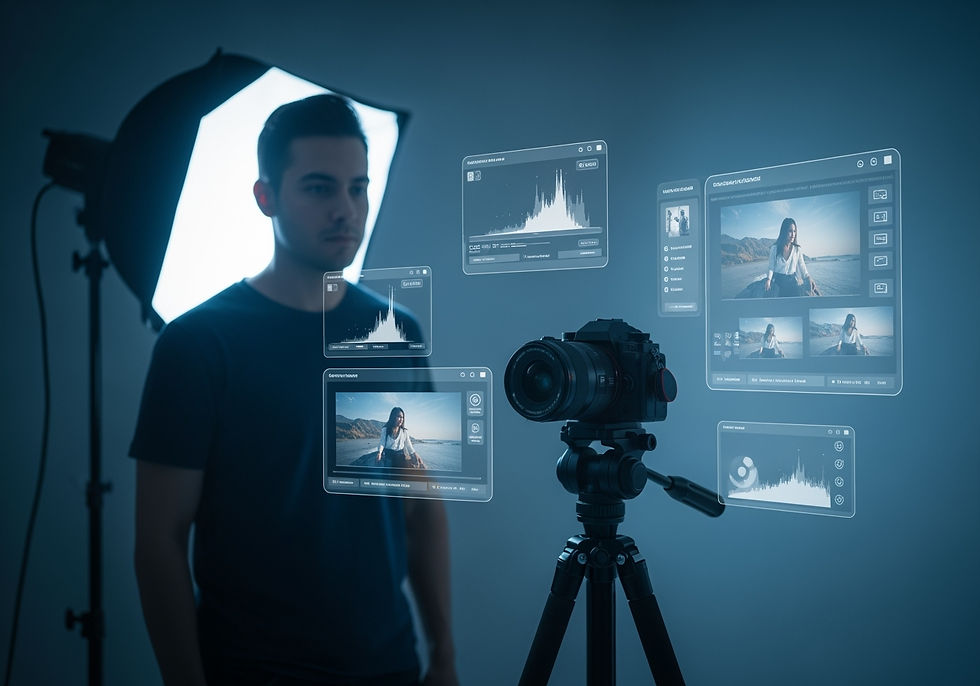🤖 How AI Is Changing the Future of Photography
- Admin

- Aug 21
- 3 min read
In recent years, AI in photography has gone from buzzword to reality. What once sounded like science fiction is now embedded in everything from your phone’s camera to high-end editing software. But is this the beginning of a creative revolution — or the end of traditional photography?
Let’s explore how artificial intelligence is shaping the way we shoot, edit, and experience images and what it means for artists like Peyman Khorram, who believe photography is about more than pixels.
📸 1. AI Inside Your Camera
Today’s cameras — especially mirrorless models — are equipped with AI-powered autofocus systems that detect eyes, faces, animals, and even vehicles.
For example:
Sony A7R V uses AI-driven subject recognition for faster, smarter tracking.
Canon’s R-series employs machine learning to enhance autofocus precision.
Even smartphones like the iPhone 15 Pro utilize AI to simulate bokeh and optimize exposure in real-time.
👉 Want to compare mirrorless camera AI systems? Check out: Mirrorless vs DSLR: Which One Should You Choose?
🧠 2. AI-Powered Editing Tools
The most obvious application of AI in photography is in post-processing. Tools like:
...allow photographers to automatically detect skies, subjects, backgrounds, and apply complex adjustments in seconds.
Instead of spending hours manually selecting hair strands or dodging highlights, AI handles the busywork — and you focus on the creative decisions.
"I see AI as a way to clear the noise so I can focus on the emotion in the frame."— Peyman Khorram
🎨 3. Generative AI: A New Form of Image Creation
With platforms like Midjourney, DALLE, and Adobe Firefly, AI can now generate entirely new images from text prompts. Type “a sunset over a Persian bazaar in cinematic lighting,” and boom — you have an image.
But here’s the question:Is that still photography?
For photographers like Peyman Khorram, generative AI isn’t a replacement — it’s a new medium. While Peyman’s work is grounded in real-world light and presence, he sees value in experimenting with AI-driven visuals for conceptual planning or storytelling references.
⚖️ 4. The Debate: Will AI Replace Photographers?
Short answer: No — but it will change the job.
AI can:
Suggest compositions
Remove distractions
Enhance sharpness or dynamic range
Even generate a background from scratch
But what AI can’t do (yet) is:
Understand human emotion
Build trust with a subject
Capture real, imperfect, beautiful moments
Photography is more than technical perfection. It's about human connection — something no algorithm can truly replicate.
Peyman’s portraits, such as those in the Eye Contact series, remind us that a powerful image often lies in what's not said — a silence no AI can imitate.
🌍 5. The Future: Collaboration, Not Competition
Instead of seeing AI as the end of photography, perhaps we should see it as an evolution. Much like digital replaced film, AI will redefine workflows — but the photographer will always matter.
In Peyman’s view, AI is a tool, not a threat. The soul of photography still comes from the eye behind the camera.
Final Thoughts
As AI continues to grow, the key for photographers is to stay creative, stay curious, and most importantly — stay human.
Use the tools. But don’t let the tools use you.
If you’re interested in seeing how technology blends with emotion in real-world photography, visit Peyman Khorram’s portfolio or book a session to experience it firsthand.



Comments